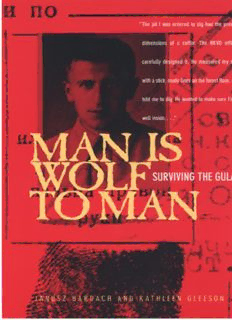
Man Is Wolf to Man: Surviving the Gulag PDF
Preview Man Is Wolf to Man: Surviving the Gulag
Man Is Wolf to Man Man Is Wolf to Man Surviving the Gulag Janusz Bardach Kathleen Gleeson UNIVERSITY OF CALIFORNIA PRESS . Berkeley Los Angeles University of California Press Berkeley and Los Angeles, California © 1998by The Regents of the University of California Library of Congress Cataloging-in-Publication Data Bardach, Janusz. Man is wolf to man : surviving the gulag / Janusz Bardach and Kathleen Gleeson. p. cm. ISBN 0-520-90094-4 1. Bardach, Janusz. 2. Political prisoners—Russia (Federation)— Kolyma Mountains Region—Biography. 3. Kolyma (Concentration camp)—History. 4. Kolyma Mountains Region—History—20th century. I. Gleeson, Kathleen. II. Title. DK771.K67B373 1998 940.54(cid:1)7247(cid:1)09577—dc21 98-5402 CIP Printed in the United States of America 9 8 7 6 5 4 3 2 1 The paper used in this publication meets the minimum requirements of American National Standards for Information Sciences— Permanence of Paper for Printed Library Materials, ANSI Z39.48-1984. To the memory of my parents, Ottylia and Mark Bardach. JB Contents Maps and photos follow pages xvi and 172 respectively Foreword by Adam Hochschild ix Acknowledgments xv Prologue 1 September 1939 3 Witness 26 Red Army Soldier 54 Court-martial 78 Cattle Car 92 Retribution 109 Burepolom 122 Siberian Trail 140 Buchta Nakhodka 163 Slave Ship 181 Welcome to Kolyma 195 The Isolator 213 Winter 224 Kolyma Highway 240 Central Hospital 259 Tuberculosis Patients 280 Antechamber to the Morgue 302 Psychiatric Ward 324 Letters 347 Free, But Not Home 364 Epilogue 385 Glossary 389 Foreword The Soviet empire of Stalin’s day is a world hard for most of us to imagine. Seldom has any nation endured such a massive, self- inflicted genocide. And seldom, if ever, has a major country kept so high a proportion of its own people, and those of countries it dominated, in prison. We know now that during Stalin’s lifetime more than 20 million Soviets—more than one out of eight men, women, and children—were executed by firing squads or sent for long terms to the gulag. After the Soviet Union and Nazi Ger- many divided Eastern Europe between them in 1939 and 1940, hundreds of thousands more people from Poland, Romania, and the Baltic states found themselves in Soviet execution cellars or in the far-flung network of labor camps. A traveler today can find Polish and Lithuanian names on prisoners’ graves from the Arc- tic Ocean to the steppes of Kazakhstan. Few Americans are aware that the most notorious corner of the gulag, that country within a country, lay only a few hundred ix
Description: